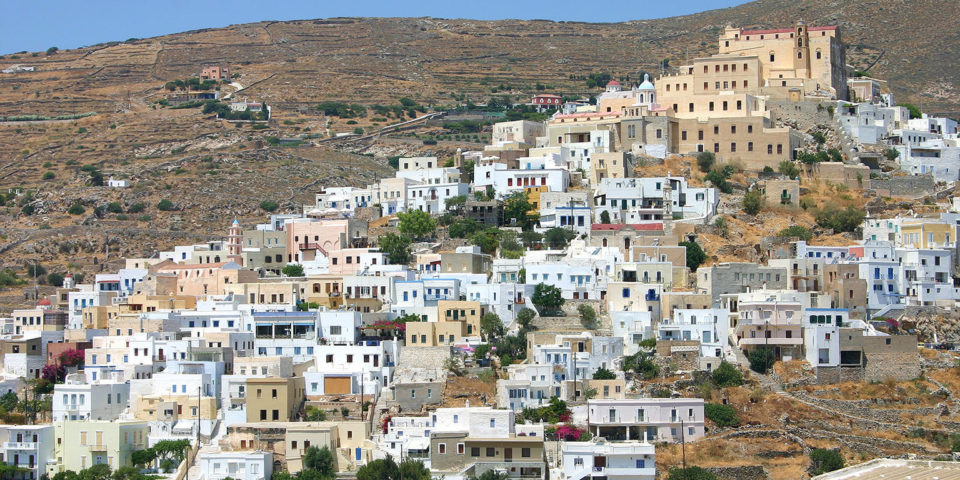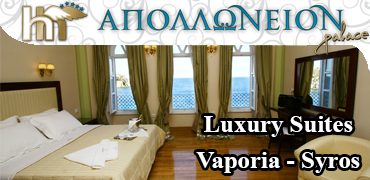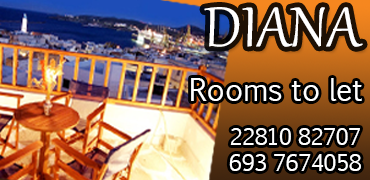General information about Ano Syros
[grid id=6360]
Historical throwback
To the summit of the settlement is found the catholic church of St. George. The original building was probably built in 1200 AC and today’s renovated church in 1834. Next to it are the Historical Archives of the Catholic Bishop, where was housed the Priests’ School (1837). The archive is very important and includes manuscripts from the 16th century.
There is also vast interest in the Archives of the Municipality, which are preserved in centuries and show the correct organization of the first Municipality of Greece.
The Capuchin monastery with the church of St. John was built in 1635, the Convent of the Jesuits with the church of Our Lady Carmel, built in 1581, and a library with thousands of books, historical documents and parchments. The church of Sa Bastia (San Sebastian) is also seen there, as well as the Cemetery of Angels (old cemetery for non-baptized children).
To the highest point in Ano Terma, is the bust of the ancient philosopher Ferecydes, while after Kyperousa, to the northern side, is the cave of his winter residence.
Previously, there existed many windmills. Remnants of one of them are next to Ferekydes’ bust.
The only orthodox churches at Ano Syros are those of Agia Triada and St. Nicholas the Poor.
There is also the Museum and the bust of the popular folk composer Markos Vamvakaris at the namesake square.
Also the visitor can see the old French Hospital, the exhibition of traditional occupations, the old historical archives and the Museum of Popular Art.
FOOD – FUN – SHOPS
Inside the settlement, there are many taverns, cafes, bars, bakeries, mini markets, traditional textiles and other shops.
Sightseeing
St Georges’ church
Open July and August from 11:00 to 14:00 and 18:30 to 21:00
Covering a short distance, you will head to the top of the hill, where you will see the beautiful church of Saint George (St. George), the Catholic cathedral. It is a three-aisled basilica, with two rows of marble columns, beautiful murals, wooden organ (harmonium), icons, statues of angels, etc. The original building was built in 1200, but today’s restored church dates from 1834. Beside it, is found the important Archive of Historical Studies of the Catholic Diocese (1837, former seminary), with precious manuscripts from the 16th century and onwards.
Women’s Convent of the Order of St. Francis
Going down to the inside of Ano Syros, you will find on your left the simple external convent of the Order of St. Francis (single Clarissa), a former Jesuit convent that functioned continuously from 1743 to 1995. You can see the spectacular gallery inside, the interesting library and the wonderful decor, as well as the church of Our Lady of Carmel (1744), with its remarkable eponymous image.
Capuchin Monastery
Just below is the Capuchin Monastery (1633) with the historic church of St. John (1635), although now only the abbot stays there and you may find it closed. In the courtyard of the monastery the elders of the island used to meet and in the basement of St. John there are crypts that initially served as shelters from pirate raids, while from 1896 and onwards they host bones and tombstones of old families of Ano Syros.
Piazza
Going a little further you will reach Piazza, the central winding road that brings together all the commercial activity of Ano Syros. Here are many public buildings, shops, restaurants, and coffee bars. The Piazza vertically intersected by steep streets, which most lead to the top. However, the most remote home of Ano Syros is only 150 meters away from the Piazza, which means that the ride will not be tedious.
Markos Vamvakaris’ Museum
Open only during the summer months from 10:30 to 13:00 and from 19:00 to 22:00.
The Museum of Markos Vamvakaris was founded in 1995 in an old house in the center of Ano Syros, which was renovated to accommodate the personal belongings of the great troubadour, who was born in Ano Syros in 1905 and spent there the first years of his life.
Fans of Markos will find in the museum old photos and memorabilia, his passport and identity, clothing and shoes, manuscripts and lyrics, the ring and his watch and other personal items that were donated by his family to be exhibited in the museum that bears his name.
Since 2000 in fact, the Municipality of Ano Syros organizes every summer a folk music festival in his memory, entitled «Musical Journeys …. the streets of Markos’, which is always a big success.
Exhibition of Traditional Crafts
Located at the beginning of the main street (Piazza), it hosts machines and tools of various traditional professions, such as the cobbler, the barber, the tailor, the carpenter and the fisherman. Old farm and forage equipment and utensils are also displayed, such as colter, plow, traditional transport containers for milk, etc. At the exhibition there is even a loom.
Archive of the Municipality – Industrial and Handicraft Association of the Women of Ano Syros
Open Monday to Friday from 9:00 to 14:00 (Municipal Archives)
Open daily from 9:00 to 13:00 (Industrial and Handicraft Association of the Women of Ano Syros)
Nearby you will find the archive of the municipality with interesting exhibits and documents showing the organization of the first municipality of the Greek state and the Industrial and Handicraft Association of Women of Ano Syros in the center of Piazza with great folklore interest.
Church of the Holy Trinity – St. Nicholas the Poor – Church of St. Sebastian
Near the Archive of the Municipality is the church of the Holy Trinity, while next to the Kamara (Kato Terma) you will see St. Nicholas the Poor, which is the oldest church on the island of mid-16th century. Of equal interest is the church of San Bastia (St. Sebastian) on the western edge of town.
Ano Mera
Agios Athanasios and Pigi (the Source)
In the great valley that stretches before us distinguishes the church of St. Athanasius and the Source that previously provided water to Ano Syros.
On the back side of Ano Syros, after 500 meters, in a truly stunning location, there is the Orthodox church of St. Athanasius. At the bottom of the ravine, between the trees is the Source. In the area grow rare crocuses and at the stone basins there women used to wash their clothes. The water they needed for cleaning and housework was carried at home on the back with earthen pitchers. Even today during the spring, several women wash carpets and rugs spreading them in the surrounding terraces.
Cave Ferekidis
Leaving Hermoupolis, follow the road towards Ano Syros and Chalandriani. One kilometer from the Lower End (Kamara) of Ano Syros and after passing the church of Our Lady Kioura, we can see to our left the church of Agia Paraskevi, as well as the ruins of windmills that are located on top of a huge rock.
After about 1.5 miles, we come to the picturesque village Foinikia, a small and sparsely populated village. At the end of the uphill we find the rural hamlet of Mytakas. From here, a concrete road leads us to the highest peak of Syros, Pyrgos, where we can enjoy the spectacular views of Syros and the surrounding areas. From Mytakas there are two detours on the right. The first passing by the church of Our Lady Kardiani, protector of Mytakas, the green Senero and the Church of St. Panteleimon ends in the agro-pastoral settlement Papouri. The second detour leads to Platos.
From Mytakas, if you head north, you will also meet the rural settlement Kyperousa, one of the most beautiful estates in the island. In the white and always clean house distinguished, the architecture of Syros is faithfully reflected. Among the neat fields, the chapel of St. Theresa gives a beauty to the landscape. In the area, one can find local wine and thyme honey. After 100 meters a detour to the right leads to Richopo, from where one can hike to get to the cave of the philosopher Ferekides. At the end of the road you leave your car and continue on foot for about 15 minutes, descending towards the sea side.
Asphalt from Mytakas leads to Chartiana, another picturesque village, full of scents of thyme and sage, and the area is ideal for hiking to the great beaches of Barbarousa and Aetos.
Chalandriani – Kastri – Kambos
After continuing to the north, we reach the small village of Chalandriani with wonderful view of the sea and the neighboring islands. Previously, the site was used for burial of the neighboring settlement «Castri.» From the chapel of Our Lady of Chalandriani, you can admire the stunning view. Our Lady of Chalandriani took the name of the region where it was built. The name is derived from the name “Chalantra” which means “Ruins of houses». In the small archaeological site you can see ancient burial monuments and statues. Then you can enjoy exquisite delicacies in the nearby taverns.
Chalandriani and Kastri findings of the third millennium BC witness the distant past of the island. The castle is a prehistoric settlement, which was well fortified to protect the locals from their enemies.
Returning to the main road, you will head to the wonderful and once abandoned village of St. Michael, whose homes are restored. Stopping here, you can enjoy good tapas and traditional dishes made from local products.
Then the asphalted road leads us to the beautiful Kambos. From here two marked trails will lead you to the beautiful and pristine beaches Lia and Grammata. The bay of Grammata is so quiet that the boats that visit it, do not need to anchor closer to the shore. That is why there found refuge many captains who transported pilgrims to the nearby Cycladic islands, like the sacred island of Delos and after, to the Virgin Ekantotapyliani in Paros. There, as the pilgrims were waiting for the weather to improve, they inscribed on the huge rocks on the coast, prayers and wishes to the gods and later to Christ, the Virgin and the Saints. Starting from Kambos, you can visit the source of Sirigas in the village, with the stunning sea view.







